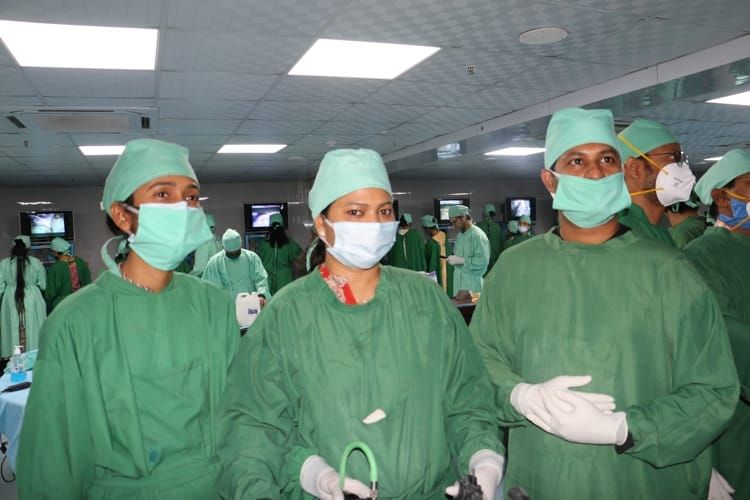Event Date: Wed - 10 May, 2023
Event Time: 9:05 am
Location: World Laparoscopy Hospital
Institute: WLH
In an interactive wet lab, surgeons engage in hands-on training and practice various laparoscopic procedures on live tissue. Let's take a closer look at the mentioned procedures:
-
Laparoscopic Cholecystectomy: This is a minimally invasive procedure to remove the gallbladder. It involves making small incisions in the abdomen to insert a camera and surgical instruments, allowing the surgeon to visualize and remove the gallbladder.
-
Laparoscopic Appendectomy: This procedure is performed to remove an inflamed appendix. It involves the insertion of a laparoscope and specialized instruments through small incisions in the abdomen, enabling the surgeon to locate and remove the appendix.
-
Transabdominal Preperitoneal (TAPP) Repair of Hernia: TAPP is a laparoscopic technique used to repair certain types of hernias, such as inguinal hernias. It involves accessing the hernia site through small incisions and reinforcing the weakened abdominal wall using mesh or sutures.
-
Duodenal Perforation Repair: Duodenal perforation refers to a hole or rupture in the duodenal wall, which may require surgical intervention. In laparoscopic duodenal perforation repair, the surgeon uses minimally invasive techniques to close the perforation and restore the integrity of the duodenum.
-
Splenectomy: A splenectomy is the surgical removal of the spleen. In laparoscopic splenectomy, small incisions are made in the abdomen to access and remove the spleen. This procedure is often performed to treat certain blood disorders, tumors, or traumatic injuries to the spleen.
-
Nephrectomy: Nephrectomy involves the surgical removal of a kidney. In laparoscopic nephrectomy, the surgeon uses specialized instruments and a laparoscope to remove the kidney through small incisions. This procedure may be necessary in cases of kidney disease, cancer, or organ donation.
It's important to note that these procedures require specialized training and expertise. Surgeons often undergo extensive education and hands-on practice to master laparoscopic techniques before performing them on actual patients. Wet lab sessions provide a controlled environment for surgeons to refine their skills and familiarize themselves with the specific challenges and nuances of each procedure.
World Laparoscopy Hospital: A Hub of Contemporary Learning with Daily 8-Hour Hands-On Laparoscopic Training
In the realm of medical education and training, there are institutions that stand out as pioneers, constantly pushing the boundaries of what is possible. One such institution is the World Laparoscopy Hospital, where a contemporary event unfolds every day, featuring a remarkable 8-hour hands-on laparoscopic training program.
A Daily Revolution in Learning
At the heart of the World Laparoscopy Hospital's mission is the commitment to train the next generation of surgeons and medical professionals in the art and science of Minimal Access Surgery. What makes this institution truly exceptional is its daily 8-hour hands-on laparoscopic training program.
The Laparoscopic Revolution
Laparoscopic surgery, often referred to as minimally invasive surgery, has revolutionized the field of surgery in recent decades. Instead of large incisions, this technique involves making tiny keyhole-like openings through which a camera and surgical instruments are inserted. This results in significantly reduced patient trauma, shorter recovery times, and less post-operative pain.
The Daily Experience at World Laparoscopy Hospital
Every day at World Laparoscopy Hospital is a contemporary event in the world of medical education. Here's a glimpse into what a typical day looks like for those fortunate enough to train at this prestigious institution:
1. Intensive Training: The 8-hour hands-on laparoscopic training is an immersive experience where trainees work side by side with experienced surgeons. This hands-on approach ensures that students gain practical skills and confidence in performing laparoscopic procedures.
2. State-of-the-Art Facilities: The hospital boasts state-of-the-art facilities, equipped with the latest laparoscopic instruments and technology. Trainees have access to the same tools and equipment used in modern surgical practices around the world.
3. Expert Faculty: The training is conducted under the guidance of expert faculty members who are pioneers in the field of Minimal Access Surgery. Their wealth of knowledge and experience provides students with invaluable insights and mentorship.
4. Customized Curriculum: The training program is tailored to the specific needs and experience levels of each student. Whether you are a novice or an experienced surgeon looking to refine your skills, there is a program to suit your requirements.
5. Global Reach: World Laparoscopy Hospital attracts medical professionals from all corners of the world. This diverse group of trainees fosters cross-cultural exchanges and collaborations, enriching the learning experience.
6. Research Opportunities: Beyond the hands-on training, the hospital also serves as a hub for research and innovation in the field of Minimal Access Surgery. Trainees have the opportunity to participate in cutting-edge research projects.
Impact Beyond the Classroom
The impact of the daily 8-hour hands-on laparoscopic training at World Laparoscopy Hospital extends far beyond the classroom. Graduates of this program return to their respective countries armed with advanced skills, contributing to the global dissemination of minimally invasive surgical techniques. Patients around the world benefit from the reduced invasiveness, faster recoveries, and improved outcomes that these skilled professionals bring to their practice.
In conclusion, World Laparoscopy Hospital's commitment to daily 8-hour hands-on laparoscopic training is a testament to its dedication to excellence in medical education. By offering a world-class learning environment and fostering a culture of innovation, this institution is shaping the future of surgery, one trainee at a time. It is not just an institution; it is a beacon of hope for patients and a driving force in advancing the field of surgery.


